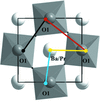issue contents
August 2015 issue

Cover illustration: APIs in the design of multi-component functional solids. See Fig. 1 of Gryl [(2015), Acta Cryst. B71, 392-405].
opinions
Many aspects of co-crystals, including their synthesis, characterization and possible applications, are receiving considerable attention from academia and industry alike. The question is, can this interdisciplinary activity be translated into new fundamental insight and new solid forms of high-value materials with improved performances.
feature articles
Download citation


Download citation


Free 

This article highlights crystal engineering strategies towards optical materials based on active pharmaceutical molecules.
research papers
Download citation


Download citation


A new organic salt involving trimethoprim, an active pharmaceutical ingredient (API), is formed and characterized by X-ray diffraction techniques. The two-dimensional ab initio conformational study supported the results obtained from the solid-state survey.
CCDC reference: 1062325
Download citation


Download citation


Single crystals of three N-benzylideneaniline derivatives containing electron–push–pull groups have been grown. Two crystallize in non-centrosymmetric space groups with molecular skeletons of high planarity. Quantum-mechanical calculations strengthen the potential non-linear optical application of the compounds obtained.
Download citation


Download citation


The synthesis and structural study of three new proton transfer compounds containing amino acids are reported. Hydrogen bonding and intermolecular interactions are studied by means of the graph-set theory and the Hirshfeld surface analysis.
Download citation


Download citation


Ternary salt co-crystals were established by virtue of chemical and geometrical arguments, which give evidence that cocrystallization of multiple active pharmaceutical ingredients (APIs) could improve the solubility and bioavailability of lomefloxacin.
Download citation


Download citation


Single-crystal structures of imidazole-based inhibitors of heme-oxygenase are presented and analysed in-depth. Conformational data from crystallography, quantum mechanics analysis, and from molecular docking are in good agreement.
Download citation


Download citation


The effect of Pr on the crystal structure of BaCe1 − xPrxO3 − δ was studied. Anomalous X-ray diffraction (AXRD) was used to determine the Pr occupancy in Ba and Ce sites. The structural parameters were correlated with H-ionic conductivity and electron transport.
A quantitative method based on the identification of close-packed blocks (CPB) and the junction zones (JZ) between them is used to characterize organic molecular crystal structures. The analytical tools defined, which include two-dimensional packing fractions and molecular-based cells (MBC), allow relationships between molecular shape, substitution patterns and crystal structure to be established.
Download citation


Download citation


Crystal structure and phase transition in (NH4)3WO2F5: from dynamic to static orientational disorder
Cubic (NH4)3WO2F5 = (NH4)3[WO2F4]F exhibits a structural phase transition from dynamic to static orientational disorder. Dynamic disorder with the escape of a tungsten atom on the cuboctahedron enables the O and F atoms to be identified on a local scale and determine the real geometry of the cis-WO2F4 octahedron.
short communications
The relationship between the bond valence s and the thermal expansion rate of chemical bonds (dr/dT) has been closely approximated using the alternative three-parameter empirical model (dr/dT) = (u + vs)–1/w, where u, v and w are the refinable parameters.


 journal menu
journal menu


























